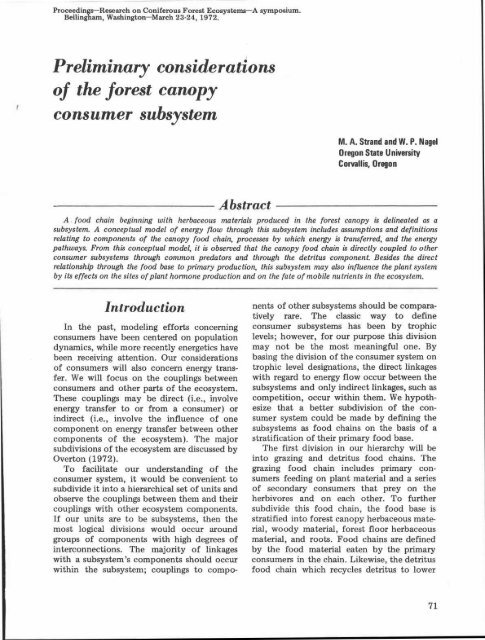PE EIE[R-Rg RESEARCH ON - HJ Andrews Experimental Forest
PE EIE[R-Rg RESEARCH ON - HJ Andrews Experimental Forest
PE EIE[R-Rg RESEARCH ON - HJ Andrews Experimental Forest
You also want an ePaper? Increase the reach of your titles
YUMPU automatically turns print PDFs into web optimized ePapers that Google loves.
Proceedings-Research on Coniferous <strong>Forest</strong> Ecosystems-A symposium .<br />
Bellingham, Washington-March 23-24, 1972 .<br />
Preliminary consideration s<br />
of the forest canopy<br />
consumer subsystem<br />
M. A. Strand and W . P . Nagel<br />
Oregon State University<br />
Corvallis, Orego n<br />
Abstract<br />
A food chain beginning with herbaceous materials produced in the forest canopy is delineated as a<br />
subsystem. A conceptual model of energy flow through this subsystem includes assumptions and definitions<br />
relating to components of the canopy food chain, processes by which energy is transferred, and the energ y<br />
pathways. From this conceptual model, it is observed that the canopy food chain is directly coupled to othe r<br />
consumer subsystems through common predators and through the detritus component . Besides the direct<br />
relationship through the food base to primary production, this subsystem may also influence the plant syste m<br />
by its effects on the sites ofplant hormone production and on the fate of mobile nutrients in the ecosystem .<br />
Introduction<br />
In the past, modeling efforts concernin g<br />
consumers have been centered on populatio n<br />
dynamics, while more recently energetics hav e<br />
been receiving attention . Our consideration s<br />
of consumers will also concern energy transfer.<br />
We will focus on the couplings betwee n<br />
consumers and other parts of the ecosystem .<br />
These couplings may be direct (i .e., involve<br />
energy transfer to or from a consumer) o r<br />
indirect (i .e., involve the influence of on e<br />
component on energy transfer between othe r<br />
components of the ecosystem) . The majo r<br />
subdivisions of the ecosystem are discussed b y<br />
Overton (1972) .<br />
To facilitate our understanding of th e<br />
consumer system, it would be convenient t o<br />
subdivide it into a hierarchical set of units an d<br />
observe the couplings between them and their<br />
couplings with other ecosystem components .<br />
If our units are to be subsystems, then th e<br />
most logical divisions would occur aroun d<br />
groups of components with high degrees o f<br />
interconnections. The majority of linkage s<br />
with a subsystem's components should occu r<br />
within the subsystem ; couplings to components<br />
of other subsystems should be comparatively<br />
rare. The classic way to defin e<br />
consumer subsystems has been by trophi c<br />
levels; however, for our purpose this divisio n<br />
may not be the most meaningful one . By<br />
basing the division of the consumer system o n<br />
trophic level designations, the direct linkage s<br />
with regard to energy flow occur between th e<br />
subsystems and only indirect linkages, such a s<br />
competition, occur within them . We hypothesize<br />
that a better subdivision of the consumer<br />
system could be made by defining th e<br />
subsystems as food chains on the basis of a<br />
stratification of their primary food base .<br />
The first division in our hierarchy will b e<br />
into grazing and detritus food chains . Th e<br />
grazing food chain includes primary consumers<br />
feeding on plant material and a serie s<br />
of secondary consumers that prey on the<br />
herbivores and on each other . To further<br />
subdivide this food chain, the food base i s<br />
stratified into forest canopy herbaceous material,<br />
woody material, forest floor herbaceou s<br />
material, and roots . Food chains are define d<br />
by the food material eaten by the primar y<br />
consumers in the chain . Likewise, the detritu s<br />
food chain which recycles detritus to lowe r<br />
71








